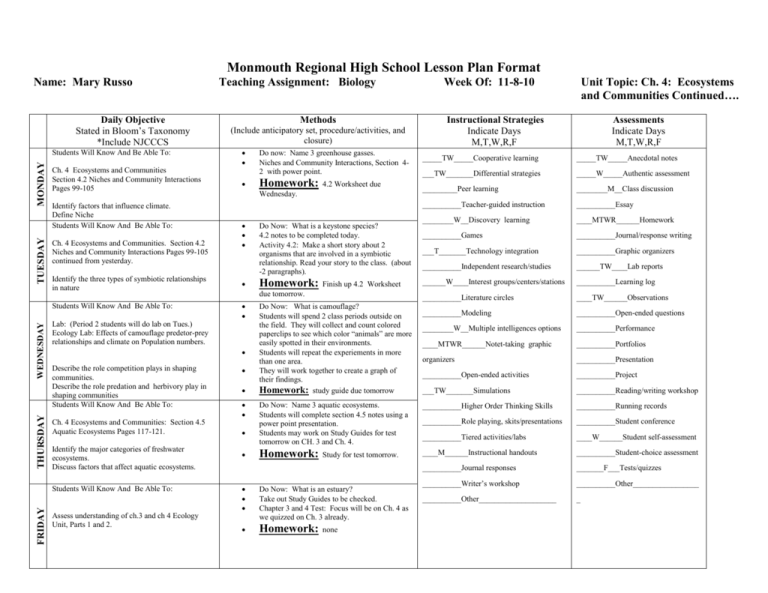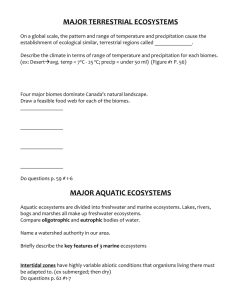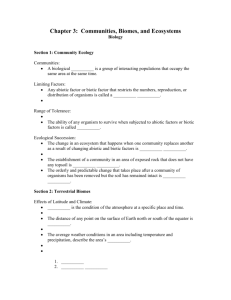Lesson Observation Form - Monmouth Regional High School
advertisement

Monmouth Regional High School Lesson Plan Format Name: Mary Russo Daily Objective Stated in Bloom’s Taxonomy *Include NJCCCS FRIDAY THURSDAY WEDNESDAY TUESDAY MONDAY Students Will Know And Be Able To: Ch. 4 Ecosystems and Communities Section 4.2 Niches and Community Interactions Pages 99-105 Identify factors that influence climate. Define Niche Students Will Know And Be Able To: Ch. 4 Ecosystems and Communities. Section 4.2 Niches and Community Interactions Pages 99-105 continued from yesterday. Teaching Assignment: Biology Methods (Include anticipatory set, procedure/activities, and closure) Do now: Name 3 greenhouse gasses. Niches and Community Interactions, Section 42 with power point. Homework: Identify the three types of symbiotic relationships in nature Students Will Know And Be Able To: Describe the role competition plays in shaping communities. Describe the role predation and herbivory play in shaping communities Students Will Know And Be Able To: Ch. 4 Ecosystems and Communities: Section 4.5 Aquatic Ecosystems Pages 117-121. Assessments Indicate Days M,T,W,R,F ___TW_______Differential strategies _____W_____Authentic assessment _________Peer learning ________M__Class discussion __________Teacher-guided instruction __________Essay ________W__Discovery learning ____MTWR______Homework __________Games __________Journal/response writing ___T_______Technology integration __________Graphic organizers __________Independent research/studies ______TW____Lab reports ______W____Interest groups/centers/stations __________Learning log __________Literature circles ____TW______Observations __________Modeling __________Open-ended questions ________W__Multiple intelligences options __________Performance ____MTWR______Notet-taking graphic __________Portfolios organizers __________Presentation __________Open-ended activities __________Project ___TW_______Simulations __________Reading/writing workshop Do Now: Name 3 aquatic ecosystems. Students will complete section 4.5 notes using a power point presentation. Students may work on Study Guides for test tomorrow on CH. 3 and Ch. 4. __________Higher Order Thinking Skills __________Running records __________Role playing, skits/presentations __________Student conference __________Tiered activities/labs ____W______Student self-assessment Homework: ____M______Instructional handouts __________Student-choice assessment __________Journal responses _______F___Tests/quizzes __________Writer’s workshop __________Other_________________ __________Other____________________ _ 4.2 Worksheet due Do Now: What is a keystone species? 4.2 notes to be completed today. Activity 4.2: Make a short story about 2 organisms that are involved in a symbiotic relationship. Read your story to the class. (about -2 paragraphs). Homework: Finish up 4.2 Worksheet Do Now: What is camouflage? Students will spend 2 class periods outside on the field. They will collect and count colored paperclips to see which color “animals” are more easily spotted in their environments. Students will repeat the experiements in more than one area. They will work together to create a graph of their findings. Homework: study guide due tomorrow Identify the major categories of freshwater ecosystems. Discuss factors that affect aquatic ecosystems. Students Will Know And Be Able To: Do Now: What is an estuary? Take out Study Guides to be checked. Chapter 3 and 4 Test: Focus will be on Ch. 4 as we quizzed on Ch. 3 already. Homework: Assess understanding of ch.3 and ch 4 Ecology Unit, Parts 1 and 2. Instructional Strategies Indicate Days M,T,W,R,F _____TW_____Anecdotal notes due tomorrow. Lab: (Period 2 students will do lab on Tues.) Ecology Lab: Effects of camouflage predetor-prey relationships and climate on Population numbers. Unit Topic: Ch. 4: Ecosystems and Communities Continued…. _____TW_____Cooperative learning Wednesday. Week Of: 11-8-10 Study for test tomorrow. none








